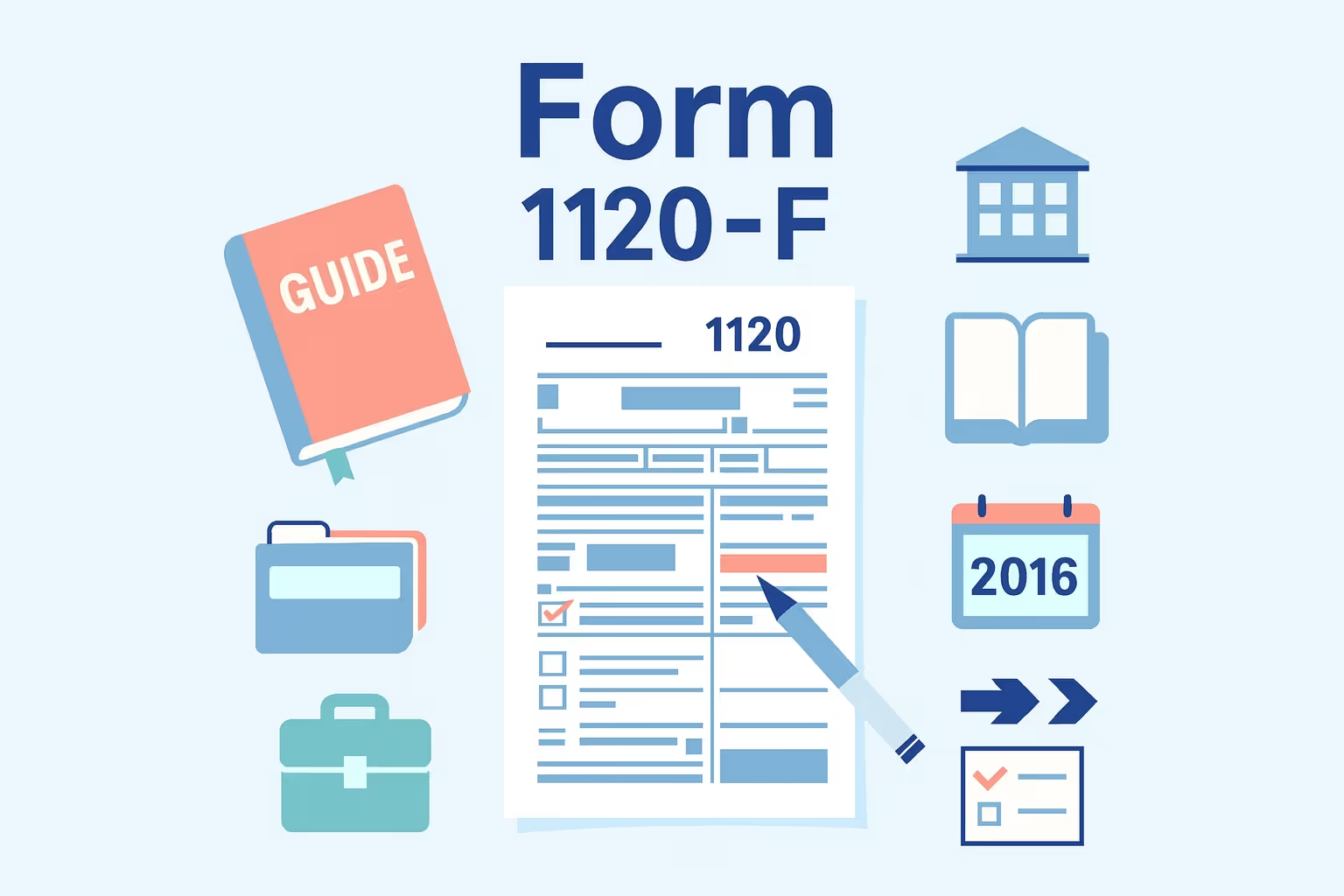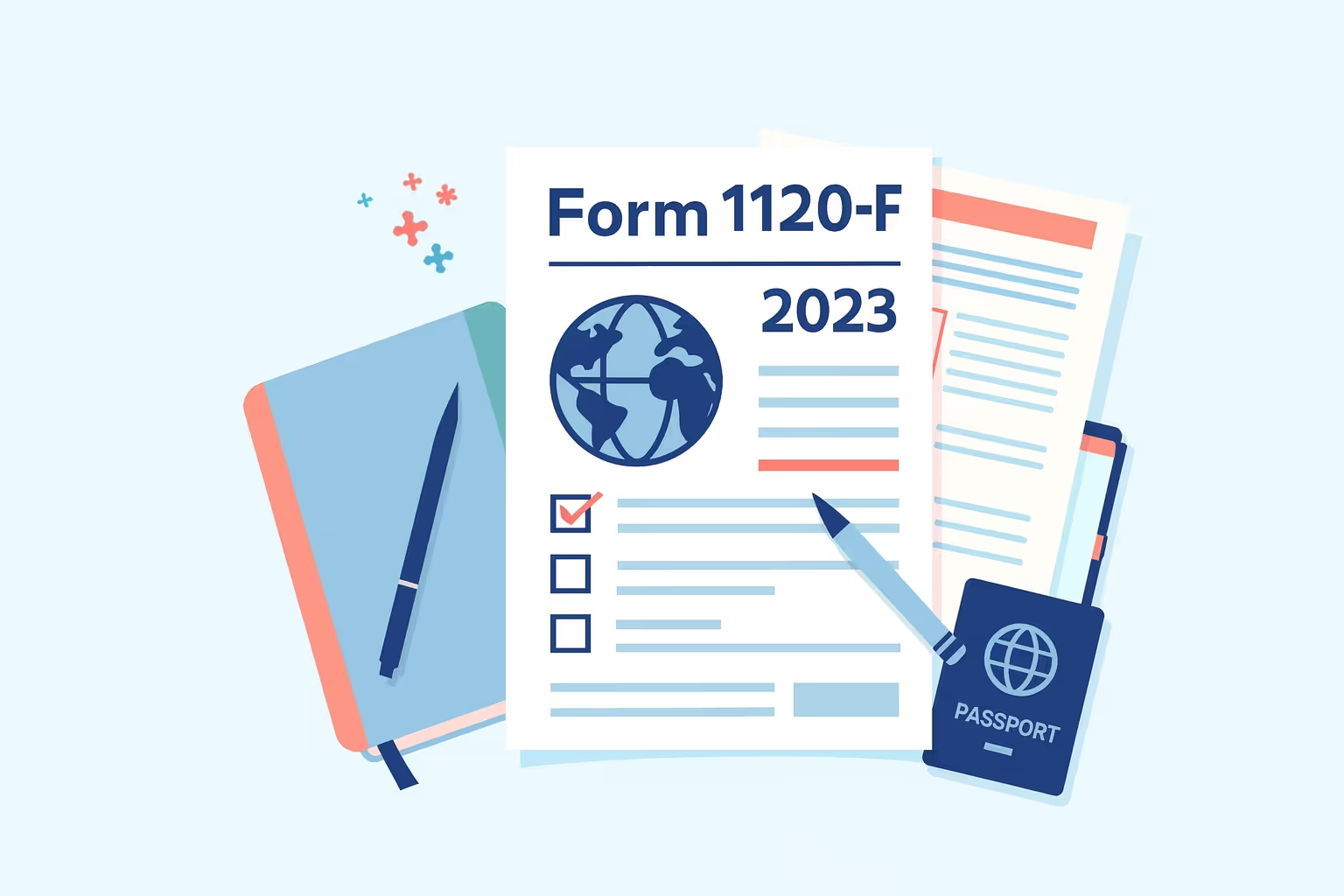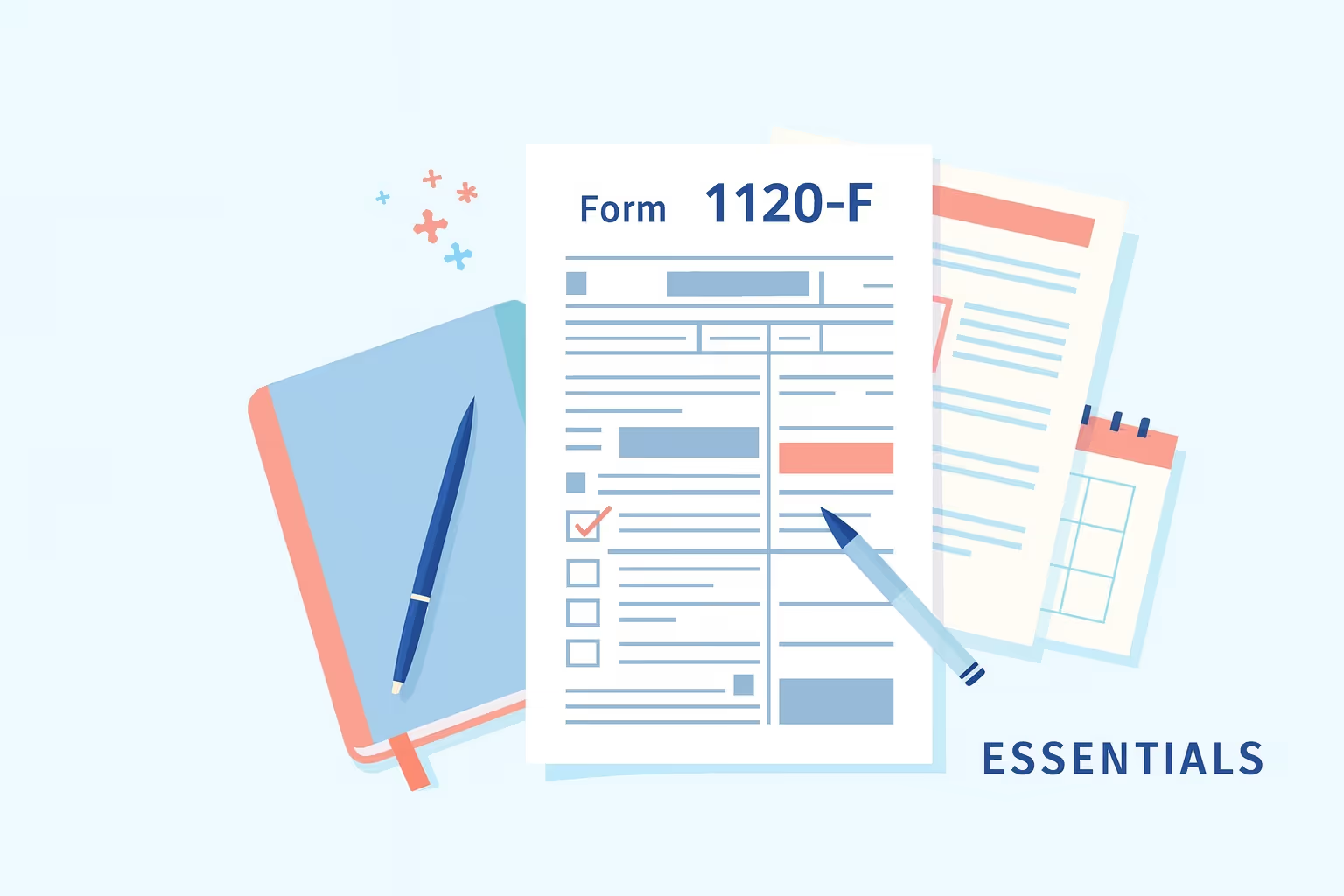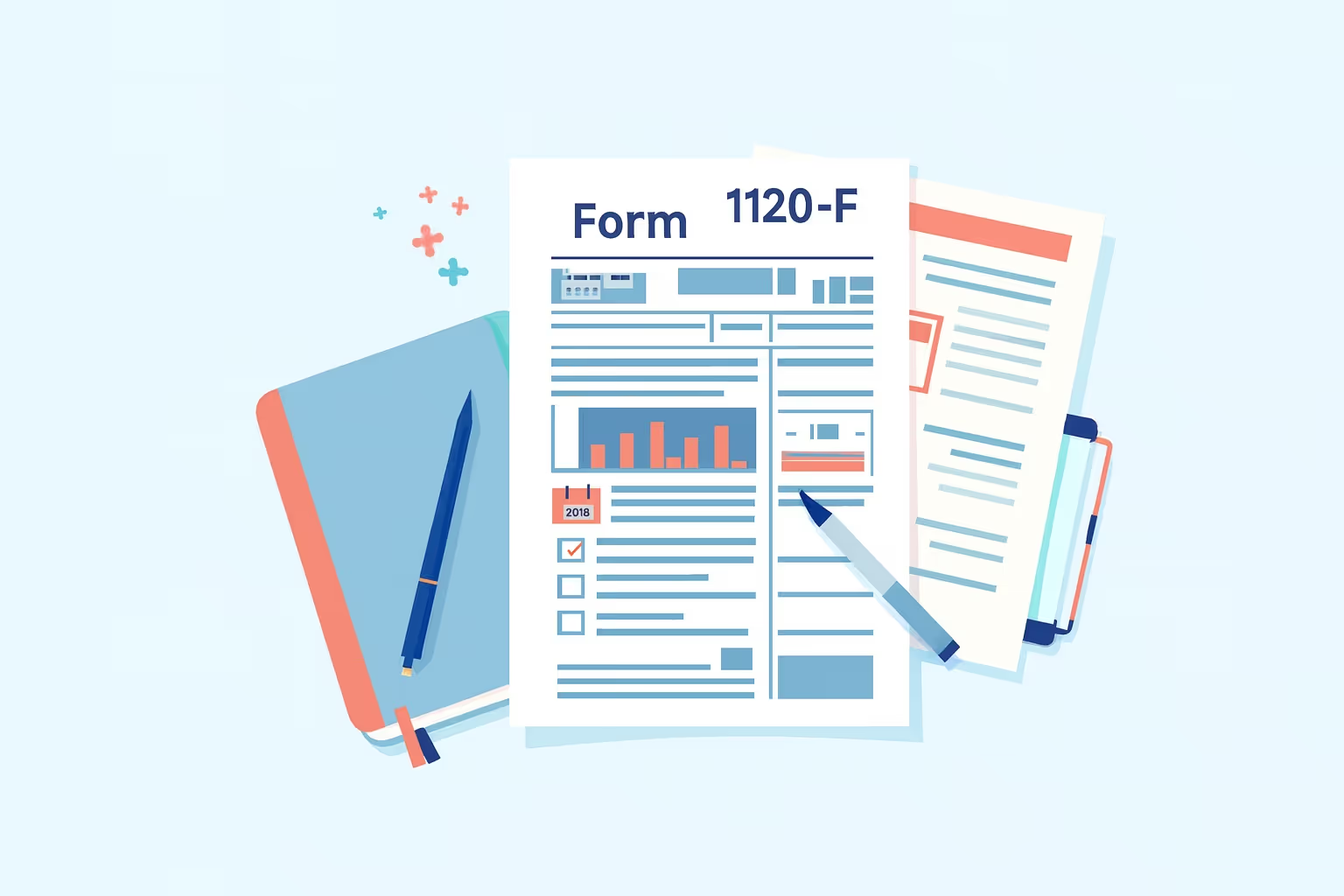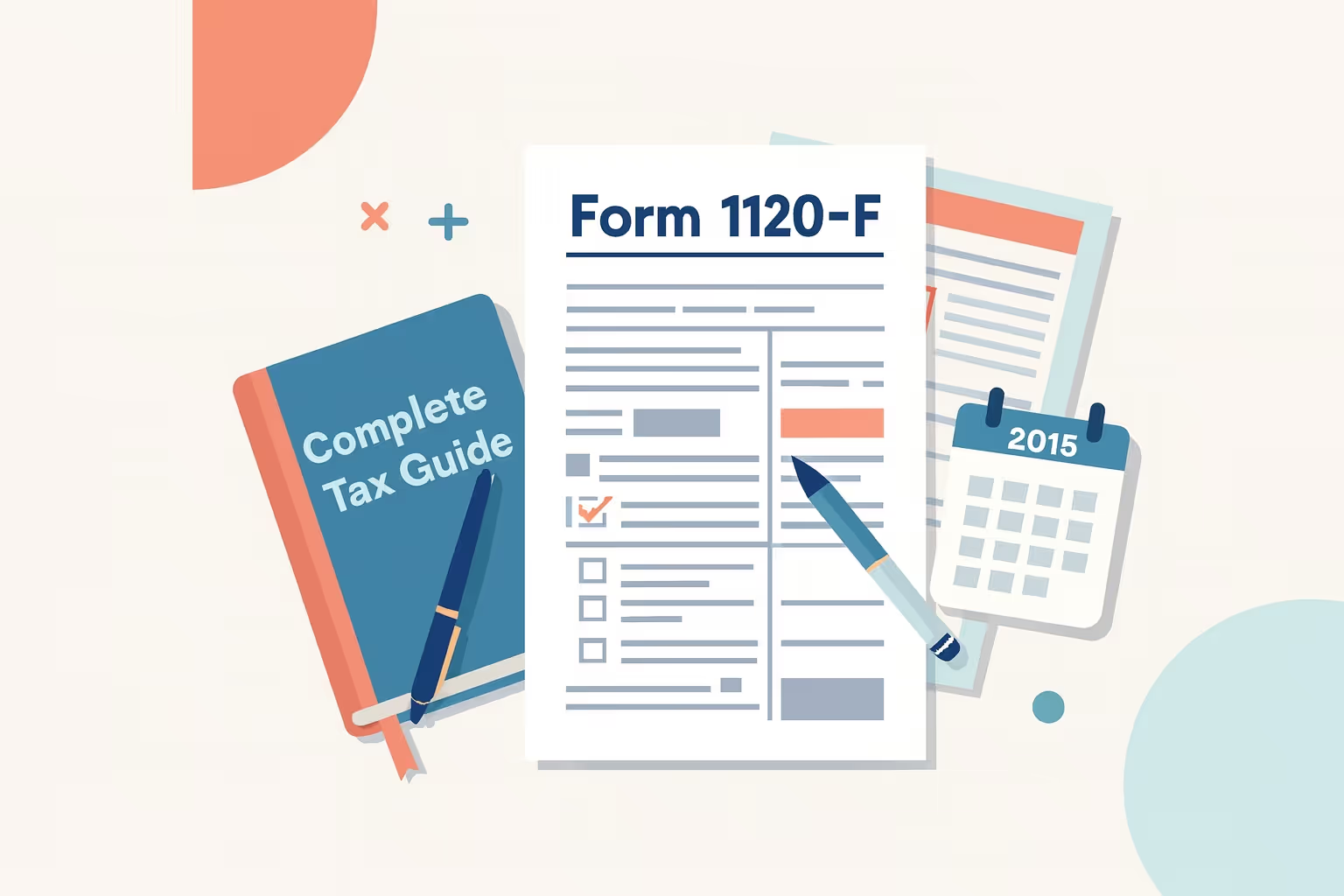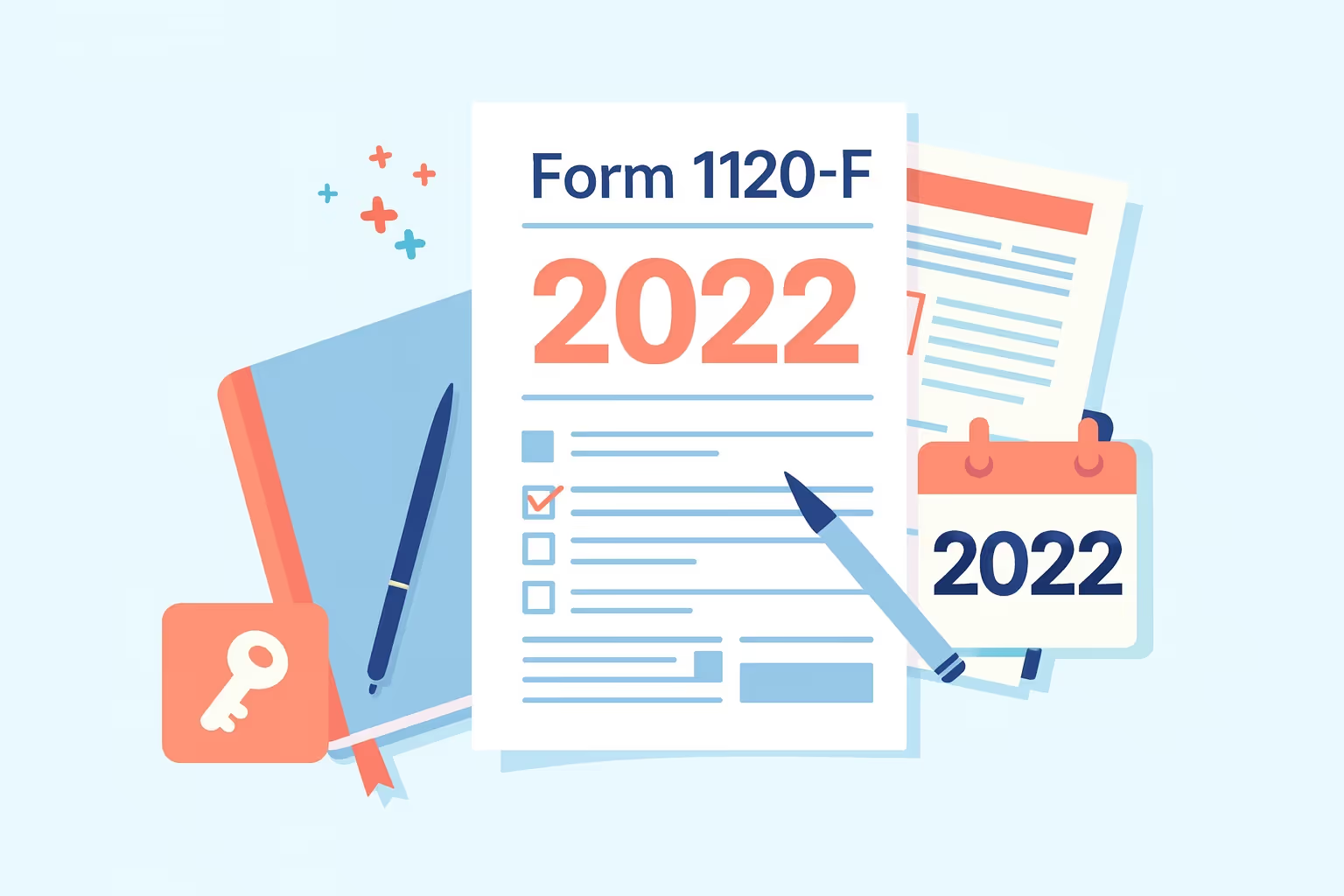Form 1120-F 2017 Instructions: Corporate Filing Guide
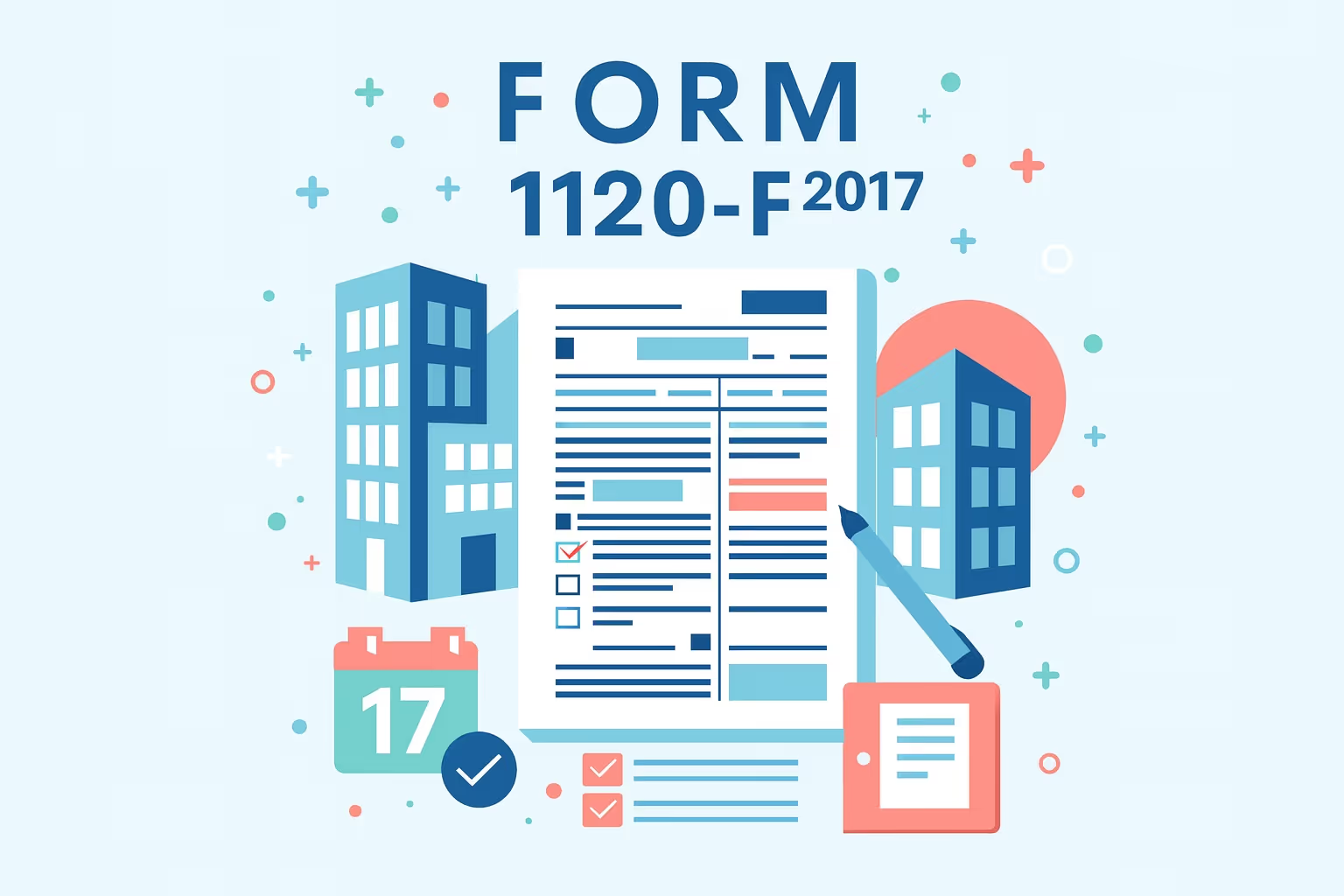
Filing an income tax return as a foreign corporation can be complex because the rules differ from those of domestic entities. Form 1120-F is the federal form required to document business income, deductions, and tax liability from U.S. activities. For the 2017 tax year, corporations must follow detailed Internal Revenue Service procedures to remain compliant.
The form addresses income effectively connected with a U.S. trade or business and other types of U.S. source income. It also covers reporting of capital assets, real property interests, and other transactions tied to U.S. operations. Understanding how Effectively Connected Income is determined is critical to calculating taxable income and applying the appropriate tax rate.
Timely and accurate filing prevents penalties, protects the right to claim deductions, and ensures the correct application of tax treaty benefits. This guide explains who must file, what has changed for 2017, and how corporations should prepare. It outlines required schedules, payment rules, due dates, and filing options, such as how to file the return electronically.
Understanding Form 1120-F 2017
Form 1120-F is the income tax return for any foreign corporation engaged in business activities within the United States. This section explains the form's purpose, who must file it, and the important exceptions. Foreign corporations use this form to report Effectively Connected Income and other U.S. source income, deductions, and credits.
Who must file Form 1120-F
- U.S. business activities: Any foreign corporation engaged in an effectively connected trade must file, even if it does not earn taxable income.
- Tax liability on FDAP income: Corporations must file when the withholding tax does not fully satisfy obligations for dividends, interest, or similar income.
- Deductions or credits claimed: Filing is required if the taxpayer requests deductions, credits, or refunds of paid U.S. tax.
- Treaty positions: A filing is necessary when claiming benefits under a tax treaty that requires disclosure on Form 8833.
- Refund claims: Corporations seeking an overpaid income tax refund must submit the income tax return.
Exceptions to filing
- No U.S. business presence: Corporations without a U.S. trade or business where full tax is withheld are generally considered exempt from filing.
- Exempt income: Certain corporations with income exempt under sections 881(c) or (d) do not need to submit a return.
- Trust and estate beneficiaries: A foreign person that is only a beneficiary of an estate or trust engaged in U.S. business does not need to file.
Core definitions: Effectively Connected Income vs. FDAP
- Effectively Connected Income: Income linked to business activities or assets within the United States, taxed at graduated rates with deductions allowed.
- FDAP income: This income encompasses fixed, determinable, annual, or periodical income, such as dividends, interest, or royalties, taxed at flat rates without deductions.
Filing deadlines and timely filing rules
- Original due date: The due date for filing is usually the 15th day of the 4th month following the close of the taxable year, or the 6th month if no U.S. office exists.
- Extension period: Corporations may file Form 7004 for an automatic extension, though tax must be paid by the original due date.
- 18-month rule: A return filed within 18 months preserves the right to deductions and credits, even if past the due date.
What Changed for Tax Year 2017
The 2017 tax year introduced several laws and updated forms affecting corporations filing Forms 1120-F. This section summarizes the key changes that impact reporting, deductions, and penalties.
Tax Cuts and Jobs Act transitional impacts.
The Tax Cuts and Jobs Act introduced blended rates for fiscal-year filers whose taxable year began before January 1, 2018, and ended after December 31, 2017.
New reporting requirements on Form 1120-F
- Question CC: Corporations must disclose whether they are qualified derivatives dealers, which affects the treatment of certain transactions.
- Section I changes: Line 2 now separates dividends and dividend equivalents per section 871(m), with updated reporting for dividend equivalents.
Entertainment expense restrictions
No deductions are allowed for entertainment expenses, club dues, or facilities related to entertainment after December 31, 2017.
Net operating loss changes
- Carrybacks eliminated: The two-year carryback rule does not apply for losses arising in years ending after December 31, 2017, except for limited exceptions.
- Future application: Carryforwards remain available, but special rules apply to certain corporations, like insurance companies.
Penalty and compliance updates
- Failure-to-file penalty: The minimum penalty is increased to the smaller of unpaid tax or $210 if the return is filed more than 60 days late.
- Protective filings: Corporations temporarily present in the United States should file protective returns to maintain deduction and credit rights.
Pre-Filing Setup for a Foreign Corporation
Before a foreign corporation begins preparing its income tax return, several steps are taken to ensure the process is accurate and compliant. This section covers eligibility checks, record requirements, and treaty considerations.
Determine if a filing requirement exists.
- Engaged in U.S. business: Corporations conducting business activities in the United States generally must file, even without taxable income or profit.
- U.S. source income not fully withheld: Filing is required when tax liability remains on income from dividends, interest, or other transactions with U.S. source items such as rents, royalties, or service fees where withholding did not fully satisfy liability.
- Claiming deductions or credits: Corporations that want to claim allowable or treaty credits must file an income tax return for the taxable year.
Verify EIN, entity details, and accounting method.
- Employer Identification Number: A valid EIN is mandatory before filing the federal form. Applications should be completed before the original due date.
- Entity classification: Confirm whether the organization is classified as a corporation, S corporation, or LLC for federal election purposes.
- Accounting method: Specify whether the corporation uses accrual, cash, or another method for reporting gross ECI, total income, and deductions.
Assess tax treaty eligibility and disclosure.
- Treaty application: If a foreign country has a tax treaty with the United States, corporations may claim lower rates on certain categories of income.
- Form 8833 requirement: Some treaty positions require disclosure with Form 8833 to validate reduced withholding or exemption from Effectively Connected Income taxation.
- Limitations: Treaty benefits often depend on meeting limitation-on-benefits provisions, which evaluate ownership, business activities, and apportionment factors.
Prepare books, records, and supporting documentation.
- Documentation standards: Corporations must retain detailed records of assets, property, services, and prior year transactions supporting taxable income calculations.
- Schedules and statements: Supporting statements may be needed to allocate interest expenses, purchase inventory property, and claim deductions in the ordinary course of business.
- State-level requirements: Business income may be subject to apportionment factors at the state level, requiring additional tax return filings beyond federal form obligations.
State and local considerations
- Out-of-state presence: Even without a federal requirement, certain states may require filing when the corporation has real property, payroll, or sales connections.
- Resident aliens or partnerships: Business relationships involving resident aliens or partnership income may trigger separate filing and estimated tax obligations.
- Special entities: Political organizations and homeowners' associations classified as corporations may also face income tax return filing requirements.
Step-by-Step Filing Instructions
Once pre-filing checks are complete, prepare the return in the same sequence the IRS form presents. Move methodically through each section, confirm every cross-reference, and document assumptions. Consistent, clear inputs reduce correspondence, prevent delayed refunds, and improve the accuracy of tax liability, credits, and any treaty-based positions claimed.
Step 1: Gather required information
As a foreign corporation, assemble identification data before preparing the income tax return. Collect legal name, address, EIN, country, date of incorporation, principal business activity code, accounting method, and book location. Gather prior year filings, financial statements, treaty documents, partnership details, capital assets records, inventory property purchased, real property interests, and Schedule UTP support.
Step 2: Complete Page 1 – Header information
On Page 1 of the federal form, enter the tax year, legal name, address, EIN, and accounting method. Check boxes for initial, final, name change, protective return, and extension. Ensure that the information matches IRS EIN records and details about the foreign country. Accuracy prevents processing delays and correspondence, whether you file electronically or by paper.
Step 3: Complete Items A through G
Complete Items A through G: country of incorporation, foreign country where income is taxed, date incorporated, location of books and records, agent information, principal business activity code, and accounting method election. Describe business activities clearly. Consistency across disclosures supports correct classification on the income tax return and avoids downstream questions or amended filings.
Step 4: Complete Page 2 – Additional information
Answer questions on page 2 about effectively connected trade, permanent establishment under an applicable tax treaty, and related party transactions requiring Form 5472. Disclose partnership interests for Schedule P, and qualified derivative dealer status for Question CC. Identify any domestic corporation relationships or out-of-state operations. Accurate responses drive schedules and documentation requirements.
Step 5: Complete Section I – FDAP income
Complete Section I for FDAP income. Report dividends, interest, rents, royalties, and other FDAP items subject to withholding or treaty reduction. Enter gross amounts, treaty country, and appropriate tax rate, typically thirty percent or lesser treaty-reduced rates. Calculate the tax, include the withholding paid, and ensure the totals are reconciled. Retain support for Form W-8 and withholding statements.
Step 6: Complete Section II – Effectively Connected Income
Complete Section II for Effectively Connected Income. Report gross ECI from sales, services, and real property, then claim allowable deductions. Allocate and limit interest expense per section 882(c). Determine taxable income at graduated rates after credits. Apply the asset use and business activities tests when classifying items from capital assets and inventory property.
Step 7: Complete Section III – Branch profits tax
Fill out Section III regarding the branch profits tax. Start with effectively connected earnings and profits, adjust for changes in U.S. net equity, and compute the dividend equivalent amount. Apply the statutory rate or a tax treaty reduction. Assess branch-level interest on excess interest expense. Attach supporting statements detailing calculations and assumptions for review.
Required Schedules and Attachments
Foreign corporations often must file additional schedules and forms with Form 1120-F. These documents prove allocations, deductions, and treaty claims. Missing or incomplete attachments may cause the IRS to deny deductions or request further information, which delays processing. Attaching the required schedules is essential for reporting taxable income and reducing tax liability.
- Schedule H: This schedule reports how deductions are assigned to Effectively Connected Income and requires clear explanations of allocation methods and supporting calculations tied to Section II.
- Schedule I: This schedule calculates allowable interest expense connected to U.S. trade and identifies any excess interest that triggers branch-level interest tax under Section III.
- Schedule P: This schedule discloses partnership allocations of Effectively Connected Income, credits, and deductions from services, inventory sales, or real property interests.
- Schedule M-3: This schedule is required for large corporations with $10 million or more in assets or receipts. It reconciles book income with taxable income differences.
- Schedule S: This schedule is used when claiming exemptions under Section 883 for international shipping or aircraft operations. It requires ownership evidence and supporting documentation.
- Form 8833: This form is filed when claiming a treaty position that overrides Internal Revenue Code rules, including reduced FDAP withholding or branch profits tax exemptions.
- Form 5472: This form is required when the foreign corporation conducts transactions with related parties. It discloses the nature, amount, and impact of those transactions.
- Form 1125-A: This form calculates and reports the cost of goods sold for corporations with inventory property purchased or produced for sale in the ordinary course.
- Form 1125-E: This form provides detailed reporting of officer compensation. It ensures payments are reasonable and properly deducted against Effectively Connected Income.
Due Date, Payments, and Electronic Filing
Filing deadlines and payment rules are critical for avoiding penalties. Corporations must monitor due dates, make estimated tax payments, and decide whether to file electronically or on paper. Each option requires accurate documentation and proof of compliance. Corporations that miss deadlines face penalties, interest, and possible deduction or credit rights.
- Original due date: The return is due the fifteenth day of the fourth month after the taxable year ends, or the sixth month if no U.S. office exists.
- Extension period: Filing Form 7004 grants an automatic extension to file, but the tax must still be paid by the original due date to avoid penalties.
- Estimated tax: Corporations must make quarterly estimated tax payments. Large corporations face stricter safe harbor rules and must reconcile their liabilities against prior years' earnings.
- Payment methods: Payments can be made through EFTPS, electronic funds withdrawal, wire transfer, card payments, or checks. All methods require documented confirmations.
- Electronic filing: E-filing is recommended for faster processing, validations, and acknowledgments. Paper filing remains allowed when specific schedules cannot be submitted electronically.
Special Scenarios and Exceptions
Some corporations fall into categories where exceptions apply. Filing requirements depend on entity type, income sources, and activities. Certain organizations, such as political organizations or homeowners' associations, may face unique rules. Other corporations with minimal or temporary U.S. activities should consider protective filings to preserve rights to deductions and credits.
- Political organizations: Organizations treated as corporations must file if they have U.S. source income. Exemptions apply only to income specifically excluded by statute.
- Homeowners associations: Associations classified as corporations may need to file when earning taxable income. Filing is required even when most income is exempt under special rules.
- Temporary activities: Corporations temporarily present with limited U.S. operations should file protective returns to safeguard deductions if income later becomes effectively connected.
- Subpart F income: Controlled foreign corporations must report subpart F income inclusions. These items affect total income and are included in taxable income computations.
- Partnership allocations: Partnerships that allocate Effectively Connected Income to a foreign corporation trigger disclosure in Schedule P and Section II computations.
Common Mistakes and Corrections
Errors frequently occur when classifying income, calculating deductions, or attaching required forms. These mistakes can result in penalties, disallowed deductions, or IRS inquiries. Reviewing the most common filing errors before submitting Form 1120-F helps corporations avoid compliance problems and ensures the correct tax rate and treatment apply to each income category.
- Misclassifying ECI: Corporations often incorrectly report ECI in Section I. Apply the asset use and business activities tests to confirm accurate income classification.
- Incorrect tax rate: Some filers apply the flat FDAP rate to ECI. Use graduated rates for ECI in Section II and apply treaty reductions to FDAP.
- Interest expense errors: Interest expense must be allocated correctly to U.S. assets. Failing to calculate excess interest may cause additional branch-level tax liability.
- Missing attachments: Failure to include Form 8833, Form 5472, or other required schedules invalidates treaty claims and related-party disclosures, leading to IRS notices.
- Unsigned or late returns: Returns missing signatures or filed past the due date lose deduction rights. Filing within 18 months preserves those rights under regulations.
First-Time Filer Tips
Corporations filing Form 1120-F for the first time must prepare carefully. These practical tips will reduce common errors, ensure accurate reporting, and create strong records for future years. Proper preparation also helps corporations manage cash flow, avoid estimated tax penalties, and secure treaty benefits where applicable.
- Maintain permanent records: Keep EIN letters, organize documents, treaty certificates, elections, and methodology memos, and store reconciliations between books and tax return lines.
- Track estimated tax: Schedule quarterly reminders for estimated tax payments. Monitor liability against results from the prior year to avoid underpayment penalties and interest.
- Document treaty positions: Keep detailed memos explaining treaty benefits and limitation-on-benefits tests. Attach Form 8833 where required and reconcile credits with withholding.
- Compare prior-year filings: Use prior-year data as a benchmark for consistency in reporting, schedules, and supporting statements across taxable years.
- Plan: Monitor changes in assets, liabilities, or business activities that affect allocations, branch profits tax, and interest expense limitations in future filings.
Glossary of Essential Terms
This glossary defines the most important terms in Form 1120-F. Understanding them helps filers classify income correctly, apply the appropriate tax rate, and complete schedules accurately. These definitions reflect how the IRS applies terms for corporations with Effectively Connected Income or other U.S.-source income obligations.
- Effectively Connected Income: Income tied to U.S. business activities or assets, taxed at graduated rates. Deductions and credits are allowed when properly documented.
- FDAP income: Fixed, determinable, annual, or periodical income such as dividends, royalties, or interest. Taxed at flat rates unless reduced by treaty benefits.
- Branch profits tax: An additional tax on effectively connected earnings not reinvested in U.S. assets. Certain treaties reduce or eliminate this tax liability.
- Real property interests: Land, buildings, and related rights. Gains from U.S. real property are treated as Effectively Connected Income under FIRPTA rules.
- Capital assets: Assets held for investment rather than sale in the ordinary course. Distinguishing them from inventory property affects reporting and applicable tax rates.
Frequently Asked Questions
Do I need to file an income tax return if withholding fully covers my FDAP income?
A return may not be required if you had no Effectively Connected Income and all U.S. tax on FDAP was withheld. Certain exceptions apply when seeking refunds, claiming credits, or disclosing treaty positions. Review the tax treaty, documentation, and due date rules. Consider a protective filing if activities were temporarily present or facts remain uncertain.
How do I decide whether items are Effectively Connected Income or FDAP for placement on the return?
Apply the asset use test and business activities test. Income tied to U.S. assets or operations is generally considered ECI, reported in Section II at graduated rates with deductions. FDAP items are placed in Part I and taxed at flat or treaty-reduced rates without deductions. Explain classification in statements when facts are mixed or evolving.
When is interest expense limited on Form 1120-F, and where is it reported?
Interest expense is limited when allotted to Effectively Connected Income under section 882(c). Use Schedule I to compute allowable deductions and any excess interest. Coordinate results with Section II and Section III to avoid mismatches. Provide methodology and tie liabilities to U.S. assets. Reconcile with prior year calculations and disclose material changes in financing.
What are the due date, original rules, and options for more time?
The original due date is usually the fifteenth day of the fourth month after the taxable year ends, or the sixth month if no U.S. office exists. File Form 7004 for an extension. Extensions do not extend the time to pay income tax. Keep proof of filing, payments, and acknowledgments for the taxpayer’s permanent records.
How should a foreign corporation handle estimated tax and potential penalties?
Make quarterly estimated tax payments based on current-year projections or safe harbors. Large corporations face stricter underpayment rules. Reconcile estimates to actual taxable income, credits, and withholding. Track cash needs from business income, other income, and gains. Document calculations and compare against prior-year trends to support amounts paid and refund claims.
Can political organizations, homeowners' associations, or other special entities be required to file?
Yes, political organizations and homeowners associations are treated as corporations that may need to file when they have U.S. source income or Effectively Connected Income. Confirm exemptions and certain exceptions available under statute or treaty. Evaluate out-of-state connections, state apportionment factors, and whether activities are business activities that alter classification or rates.
What documentation should be retained to support positions and avoid examination issues?
Keep organizing documents, EIN letters, federal election records, and treaty certificates. Retain statements for branch profits tax, U.S. net equity, and other transaction details. Preserve work papers for apportionment, interest allocation, inventory property purchased, and classification of capital assets. Maintain confirmations for amounts paid and refunds, electronically file receipts, and cross-checks to financial statements and prior returns.
















